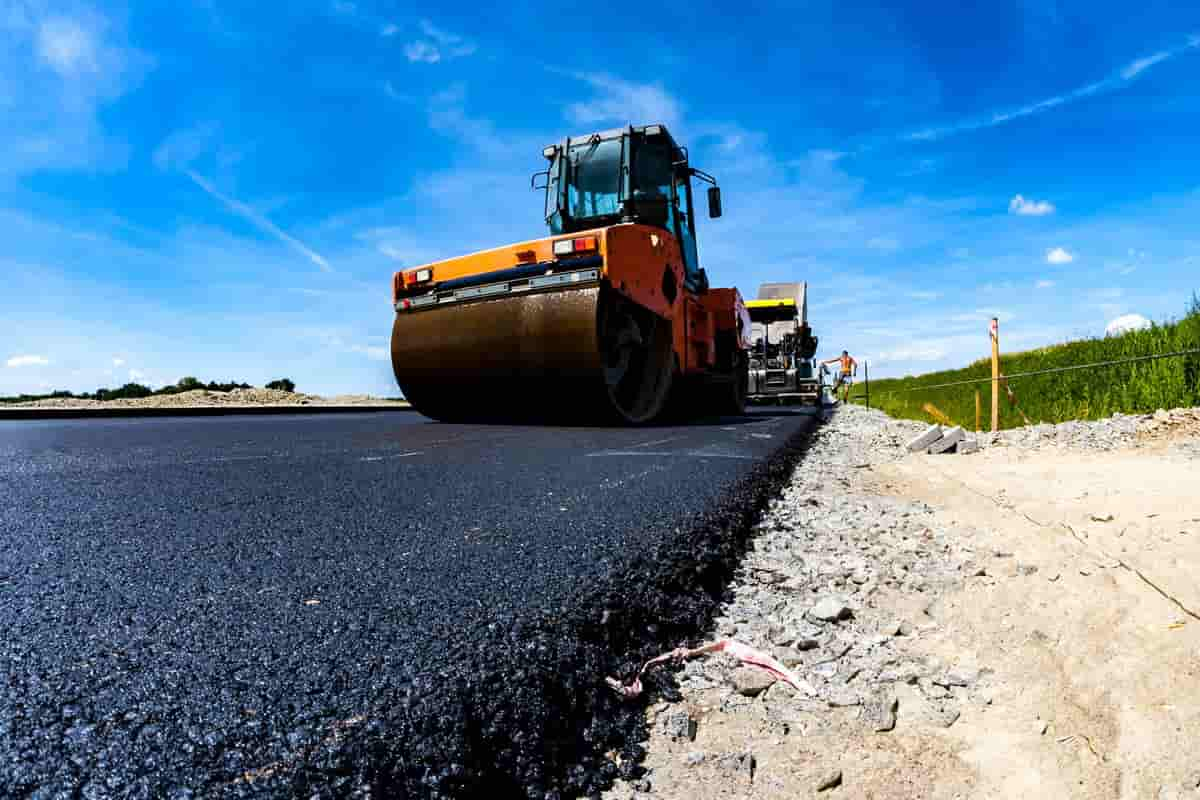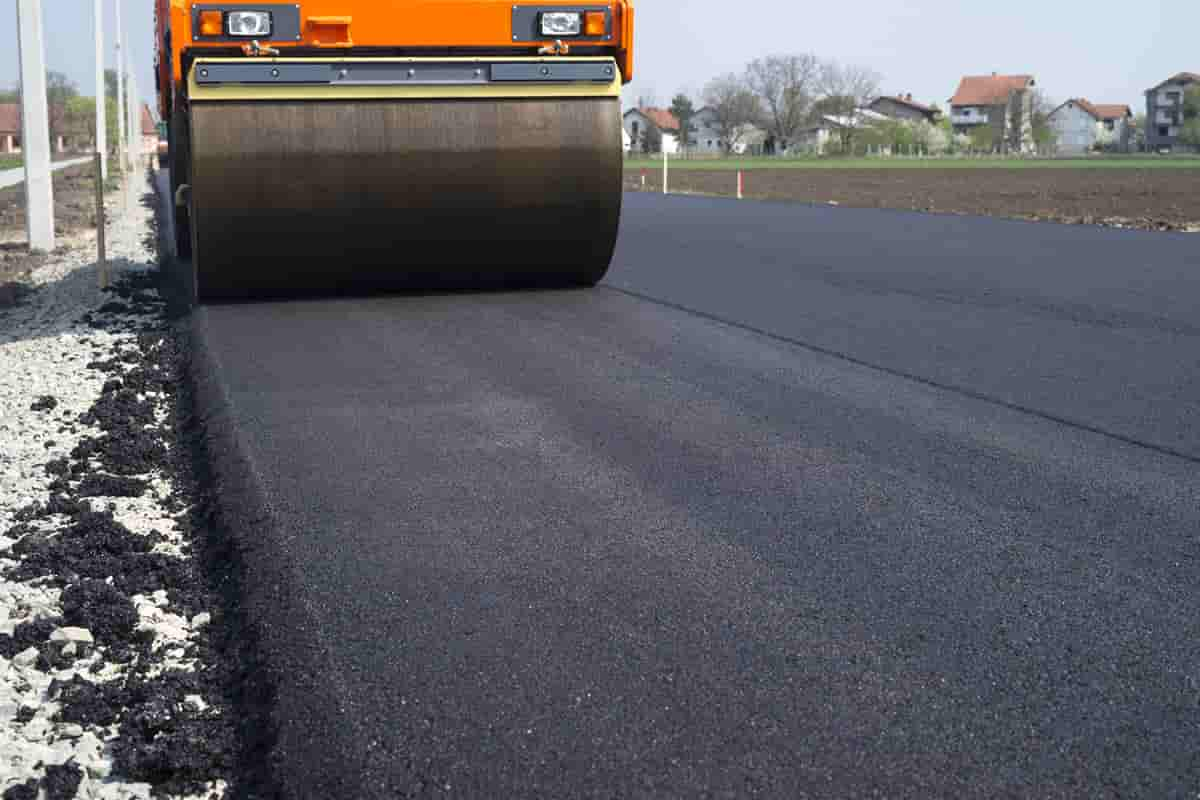Using simulative compaction tests with a Superpave gyratory compactor (SGC), the compaction characteristics of the surface layer asphalt mixture were investigated.
Asphalt Performance Grade
In this article, we are going to talk about the influence of a better grade asphalt on its overall performance. The influence of the contents of mineral aggregates of all sizes and asphalt on the compaction characteristics of asphalt mixtures was determined using an analysis of the densification curve of gyratory compaction. According to SGC tests, mixtures with higher asphalt content experience a faster increase in density, there is a perfect balance between fine aggregates and coarse aggregates for compaction, and the right amount of mineral powder improves the workability of mixtures while too much mineral powder causes them to become dry and hard. The results of SGC tests can be used to draw conclusions about how to modify material composition to improve the compaction performance of asphalt mixtures. These conclusions can also be used to predict the compaction performance of the designed asphalt mixture, which influences the choice of compaction schemes. Asphalt mixtures' compaction characteristics are frequently used to indicate how simple or complex a mixture is to compact on a road. The strength and durability of hot-mix asphalt mixtures are significantly influenced by compaction.  Asphalt mixtures can acquire the necessary carrying capacity to handle the demands of heavy traffic with proper compaction. However, there are numerous influencing factors and the asphalt concrete compaction mechanism is very complex. Any mistake made during the compaction process could compromise the overall pavement's quality and field performance. Numerous factors affect how well asphalt mixtures compact; many studies focus on temperature, rolling equipment, and other factors. Through the use of a lab rutting test, Xiao and Wang examined the compaction performance of the multilevel interlocked dense type asphalt mixture. Through tests, Stakston et al. and Aho et al. examined the impact of aggregate shape on the compaction characteristics of the mixture. Through analysis of the densification curve a feature of gyratory compaction, Hussain and Timothy proposed the idea of densification energy index. Through gyratory compaction tests, Li et al. investigated how material composition (gradation, the amount of asphalt) and compaction pressure affected compaction characteristics. However, they only compared the compaction characteristics of various gradations, such as AC-13I, AK-13A, and Superpave gradations, and did not systematically examine how gradation variety affected compaction characteristics. By using lab gyratory compaction tests, Leiva and West analyzed the fundamental compaction parameters and their relationships (such as the compaction energy index, the slope of the densification curve, and the number of gyrations necessary to reach 92% of the theoretical maximum density), laying the groundwork for an analysis of the impact of material composition (gradation, aggregate shape, binder grade, and so on) on compaction characteristic. The internal material composition of an asphalt mixture serves as the foundation for all of its external characteristics; as a result, the material composition largely determines the compaction characteristics of the asphalt mixture. There are, however, few thorough studies about the effects of material composition rules on compaction characteristics. Through the use of SGC simulative compaction tests, this paper will methodically analyze how material composition rules affect the compaction characteristics of asphalt mixtures.
Asphalt mixtures can acquire the necessary carrying capacity to handle the demands of heavy traffic with proper compaction. However, there are numerous influencing factors and the asphalt concrete compaction mechanism is very complex. Any mistake made during the compaction process could compromise the overall pavement's quality and field performance. Numerous factors affect how well asphalt mixtures compact; many studies focus on temperature, rolling equipment, and other factors. Through the use of a lab rutting test, Xiao and Wang examined the compaction performance of the multilevel interlocked dense type asphalt mixture. Through tests, Stakston et al. and Aho et al. examined the impact of aggregate shape on the compaction characteristics of the mixture. Through analysis of the densification curve a feature of gyratory compaction, Hussain and Timothy proposed the idea of densification energy index. Through gyratory compaction tests, Li et al. investigated how material composition (gradation, the amount of asphalt) and compaction pressure affected compaction characteristics. However, they only compared the compaction characteristics of various gradations, such as AC-13I, AK-13A, and Superpave gradations, and did not systematically examine how gradation variety affected compaction characteristics. By using lab gyratory compaction tests, Leiva and West analyzed the fundamental compaction parameters and their relationships (such as the compaction energy index, the slope of the densification curve, and the number of gyrations necessary to reach 92% of the theoretical maximum density), laying the groundwork for an analysis of the impact of material composition (gradation, aggregate shape, binder grade, and so on) on compaction characteristic. The internal material composition of an asphalt mixture serves as the foundation for all of its external characteristics; as a result, the material composition largely determines the compaction characteristics of the asphalt mixture. There are, however, few thorough studies about the effects of material composition rules on compaction characteristics. Through the use of SGC simulative compaction tests, this paper will methodically analyze how material composition rules affect the compaction characteristics of asphalt mixtures. 
Asphalt Performance
The surface layer asphalt mixture (13-type gradation) is the focus of this study; further studies will cover other types of mixtures. Additionally, this research does not determine whether a mixture's compaction performance is good or bad; instead, it only examines the influence rule and trend of compaction characteristics. The Superpave gyratory compactor can more accurately mimic the compaction process of mixtures under rolling and vehicles than any other test device for studying the compaction characteristics of asphalt mixtures. The densification characteristics of asphalt mixtures during construction and after traffic is opened can be assessed through observation of the height variety of test specimens in the laboratory gyratory compaction test. In this study, a Superpave gyratory compactor is used to conduct laboratory tests that enable an analysis of the effects of various material compositions on compaction characteristics. Researchers working on the Strategic Highway Research Program (SHRP) are developing methods for lab compaction for a variety of reasons. The most crucial one is to simulatively compact the test specimen to the field density. To accommodate the large mineral aggregates, larger compaction equipment is required. In order to identify unstable mixtures and other compaction issues, compaction performance tests are required. Researchers from SHRP also took the equipment's weight into account. Because the available equipment for compaction did not satisfy these requirements, the Superpave gyratory compactor was created (SGC). SGC can meet the demand for simulative compaction and is also very light in weight.  Test specimens have a diameter of 6 inches (150 mm) and can accommodate mixtures made up of mineral aggregates with a maximum size of 50 mm (or nominal maximum size of 37.5 mm). Gyratory compaction molding can mimic the movement of various construction equipment and vehicles during the paving, rolling, and traffic loading processes. The mixture is designed under a specific compaction level, just like the other mix design techniques. The designed gyratory compaction number N des, which is used to separate the differences in compaction effort, determine the compaction level in the Superpave design method. The designed ESAL can be used to indicate the traffic level, and N des is a function of that level (equivalent single axle load). The initial gyratory number N ini represents the compaction effort of paving; to prevent soft asphalt mixtures, the degree of compaction (measured as the ratio of compaction density to theoretical maximum density) must be less than 89%. The degree of compaction is required to be equal to 96% to achieve the designed air voids of 4%; the designed gyratory number N des is equivalent to the compaction effort of rolling and traffic loading until the mixture is stable. The highest gyratory number, N max, represents the compaction effort of sustained action of traffic loads. The mixture can be considered to have been destroyed if the minimum air void is less than 2%, so under the maximum gyratory number N max, the degree of compaction is required to be less than 98%. The densification curve between N ini and N des generally assumes the form of a line if the semilogarithmic coordinates are used, but the curve between N des and N max is not a perfect line. As a result, the entire densification curve can be split into two sections, each of which reflects the traits of various compaction phases.
Test specimens have a diameter of 6 inches (150 mm) and can accommodate mixtures made up of mineral aggregates with a maximum size of 50 mm (or nominal maximum size of 37.5 mm). Gyratory compaction molding can mimic the movement of various construction equipment and vehicles during the paving, rolling, and traffic loading processes. The mixture is designed under a specific compaction level, just like the other mix design techniques. The designed gyratory compaction number N des, which is used to separate the differences in compaction effort, determine the compaction level in the Superpave design method. The designed ESAL can be used to indicate the traffic level, and N des is a function of that level (equivalent single axle load). The initial gyratory number N ini represents the compaction effort of paving; to prevent soft asphalt mixtures, the degree of compaction (measured as the ratio of compaction density to theoretical maximum density) must be less than 89%. The degree of compaction is required to be equal to 96% to achieve the designed air voids of 4%; the designed gyratory number N des is equivalent to the compaction effort of rolling and traffic loading until the mixture is stable. The highest gyratory number, N max, represents the compaction effort of sustained action of traffic loads. The mixture can be considered to have been destroyed if the minimum air void is less than 2%, so under the maximum gyratory number N max, the degree of compaction is required to be less than 98%. The densification curve between N ini and N des generally assumes the form of a line if the semilogarithmic coordinates are used, but the curve between N des and N max is not a perfect line. As a result, the entire densification curve can be split into two sections, each of which reflects the traits of various compaction phases. 
Asphalt Mixture Influence
This paper primarily examines the densification curve between gyratory numbers N ini and N des; specifically, it examines the compaction properties of mixtures from paving and rolling to achieving stability under traffic loads; additionally, it examines the influence factors and regulations that determine how easily or difficultly the mixture is compacted to the intended air voids. The main issue with the densification curve between N des and N max (i.e., the process of compaction from the stability phase to the minimum air voids) is determining whether mixtures will be destroyed (i.e., have air voids less than 2%), a topic that may be covered in later research and is not covered in this paper. This essay focuses solely on the first phase's compaction characteristics. Since the densification curve between N ini and N des takes the shape of a line on semilogarithmic coordinates, this research will primarily use semilogarithmic coordinates for streamlining analysis. The asphalt mixtures of the 13-type gradation are the focus of this study. Because they represented two typical levels of bitumen content in general mixtures, the bitumen content is 3.5% and 4.5%, respectively. Basalts are used as mineral aggregates, and limestone (size less than 0.15 mm) is used as mineral powder. The tests make use of AH-90 heavy-traffic asphalt. About 160°C is the compaction temperature for asphalt mixtures.  The slope of the densification curve between N ini and N des, the degree of compaction of gyratory numbers 8 and 100, and the number of gyrations necessary to reach 92% of the theoretical maximum density are some of the data analysis indexes (G mm). The slope of the curve on the semilogarithmic coordinates depicts the speed at which mix density is increasing during compaction. If the mixture is a soft asphalt mixture, it can be determined by the degree of compaction at gyratory number 8. When the mixture achieves stability under traffic loads, the degree of compaction of gyratory number 100 can show the air void of the mixture. The number of gyrations necessary to achieve 92% G mm can be found in the densification curve; if this number is high, construction compaction is challenging. This is because many specifications call for pavements to be compacted to a density of 92% G mm. Slope contrast. Because scheme (3)'s densification curve has a slightly higher slope than does scheme (8)'s, a higher binder content will result in a faster rate of density increase. Gyratory Number 8 Density The density of mixture (3), which contains more asphalt, is higher (86.7% G mm, Table 4); the density of mixture (8), which contains less asphalt, is lower (84.9% G mm). Between mixtures (3) and (8), there is a 1.8% G mm difference, which indicates that the mixtures' initial workability was improved by more asphalt. Gyratory Number 100 Density The density of mixture (3), which contains more asphalt, is higher (97.5% G mm), while the density of mixture (8), which contains less asphalt, is lower (94.2% G mm). There is a 3.3% G mm difference between mixtures (3) and (8). The number of rotations necessary to achieve 92% Gmm. The slope of the densification curve cannot be used as the only criterion for determining whether compaction is difficult or easy; otherwise, the incorrect conclusion that more coarse aggregates make compaction easier may be drawn. It is known that the gyratory number of the scheme (3) (higher binder content) is smaller. When their gradations are the same, the mixture with more asphalt has a faster rate at which its density rises, is easier to compact, and has a smaller air void. The amount of asphalt and mineral powder in Test Schemes (1), (2), (3), and (4) is the same, but the content of coarse aggregates rises gradually and that of fine aggregates falls gradually; Figure 4 shows the variety rule of compaction characteristic with the content of fine aggregates. It illustrates how difficult it is to compact a mixture when the proportion of fine aggregates is low compared to the proportion of coarse aggregates, how compaction performance improves over time as fine aggregate content increases, and how it begins to decline as fine aggregate content increases.
The slope of the densification curve between N ini and N des, the degree of compaction of gyratory numbers 8 and 100, and the number of gyrations necessary to reach 92% of the theoretical maximum density are some of the data analysis indexes (G mm). The slope of the curve on the semilogarithmic coordinates depicts the speed at which mix density is increasing during compaction. If the mixture is a soft asphalt mixture, it can be determined by the degree of compaction at gyratory number 8. When the mixture achieves stability under traffic loads, the degree of compaction of gyratory number 100 can show the air void of the mixture. The number of gyrations necessary to achieve 92% G mm can be found in the densification curve; if this number is high, construction compaction is challenging. This is because many specifications call for pavements to be compacted to a density of 92% G mm. Slope contrast. Because scheme (3)'s densification curve has a slightly higher slope than does scheme (8)'s, a higher binder content will result in a faster rate of density increase. Gyratory Number 8 Density The density of mixture (3), which contains more asphalt, is higher (86.7% G mm, Table 4); the density of mixture (8), which contains less asphalt, is lower (84.9% G mm). Between mixtures (3) and (8), there is a 1.8% G mm difference, which indicates that the mixtures' initial workability was improved by more asphalt. Gyratory Number 100 Density The density of mixture (3), which contains more asphalt, is higher (97.5% G mm), while the density of mixture (8), which contains less asphalt, is lower (94.2% G mm). There is a 3.3% G mm difference between mixtures (3) and (8). The number of rotations necessary to achieve 92% Gmm. The slope of the densification curve cannot be used as the only criterion for determining whether compaction is difficult or easy; otherwise, the incorrect conclusion that more coarse aggregates make compaction easier may be drawn. It is known that the gyratory number of the scheme (3) (higher binder content) is smaller. When their gradations are the same, the mixture with more asphalt has a faster rate at which its density rises, is easier to compact, and has a smaller air void. The amount of asphalt and mineral powder in Test Schemes (1), (2), (3), and (4) is the same, but the content of coarse aggregates rises gradually and that of fine aggregates falls gradually; Figure 4 shows the variety rule of compaction characteristic with the content of fine aggregates. It illustrates how difficult it is to compact a mixture when the proportion of fine aggregates is low compared to the proportion of coarse aggregates, how compaction performance improves over time as fine aggregate content increases, and how it begins to decline as fine aggregate content increases.  Therefore, there is an ideal quantity of fine aggregates. When the amounts of coarse aggregates, mineral powder, and asphalt are held constant, the performance of compaction is greatly influenced by the presence of thicker fine aggregates; thicker aggregates will make compaction more challenging. The proportion of each size section among coarse aggregates above 4.75 mm has no discernible influence on compaction characteristics when the contents of fine aggregates, mineral powder, and asphalt are all held constant. Perhaps thicker coarse aggregates will contribute to compaction; this is likely because there are fewer contact points between coarse aggregate particles. The air void of the mixture with more mineral powder is smaller and easier to compact when the contents of coarse aggregates and asphalt are held constant, demonstrating that an appropriate amount of mineral powder will improve the workability of mixtures and contribute to field compaction. After a certain amount of mineral powder has been added, adding more won't help with compaction any longer because too much mineral powder will make mixtures dry and hard and hurt compaction in field construction. The mixture with more mineral powder and asphalt has a smaller air void and its density-increasing rate is faster when the amount of coarse aggregates is kept constant. The mixture that contains more mineral powder and coarse aggregates but less fine aggregates has a smaller final air void and compacts more readily, but its final air void will be insufficient. It is more difficult to compact the mixture with too many fine aggregates but not enough mineral powder, and the final air void is typically quite large.
Therefore, there is an ideal quantity of fine aggregates. When the amounts of coarse aggregates, mineral powder, and asphalt are held constant, the performance of compaction is greatly influenced by the presence of thicker fine aggregates; thicker aggregates will make compaction more challenging. The proportion of each size section among coarse aggregates above 4.75 mm has no discernible influence on compaction characteristics when the contents of fine aggregates, mineral powder, and asphalt are all held constant. Perhaps thicker coarse aggregates will contribute to compaction; this is likely because there are fewer contact points between coarse aggregate particles. The air void of the mixture with more mineral powder is smaller and easier to compact when the contents of coarse aggregates and asphalt are held constant, demonstrating that an appropriate amount of mineral powder will improve the workability of mixtures and contribute to field compaction. After a certain amount of mineral powder has been added, adding more won't help with compaction any longer because too much mineral powder will make mixtures dry and hard and hurt compaction in field construction. The mixture with more mineral powder and asphalt has a smaller air void and its density-increasing rate is faster when the amount of coarse aggregates is kept constant. The mixture that contains more mineral powder and coarse aggregates but less fine aggregates has a smaller final air void and compacts more readily, but its final air void will be insufficient. It is more difficult to compact the mixture with too many fine aggregates but not enough mineral powder, and the final air void is typically quite large. 
